What's it like to be an elementary school principal in Palm Springs? Hint: It's not easy
Ever wondered what it’s like to be an elementary school principal in charge of the safety and education of over 400 children?
Well, I got to find out… kind of. (Hint: It’s hard.)
Before festivalgoers descened upon the Coachella Valley (and festival season consumed my schedule), I was “principal for a day” at Cahuilla Elementary in Palm Springs.
Don’t worry, parents. I was not actually put in charge of the school. I didn’t cancel homework, get rid of math or let everyone stay at recess all day although that would have been fun.
Instead, I shadowed the real Cahuilla Elementary principal, Dr. Ryan Saunders.
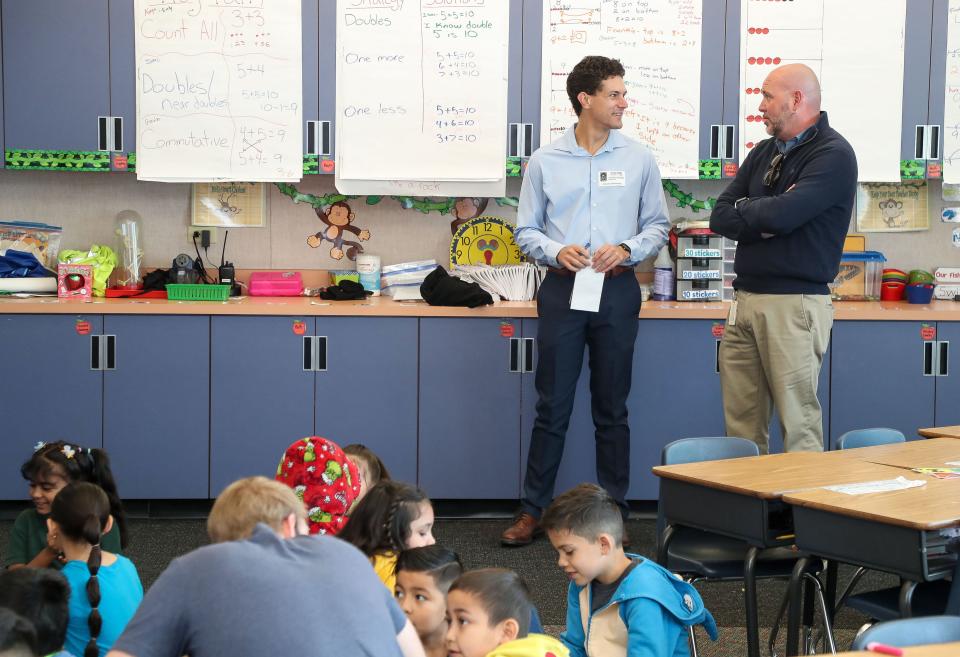
My goal was to get a sense of what it’s like to manage a school with nearly 20 teachers, 50-plus employees and roughly 420 students — 90% of whom come from socioeconomically disadvantaged backgrounds, according to state data.
From 7 a.m. until early afternoon, I tagged along with Saunders — and sometimes a posse of half a dozen principal-adoring, attention-seeking students clinging to his side at recess. All day, I noted what it’s like to be him.
I watched as he dealt with a staffing crisis, checked on classrooms, managed recess and made purchase orders. In over four hours, he and I barely sat down.
It was pretty exhausting. I couldn’t imagine doing the real job for 180 school days a year.
Here’s a diary of what went down:
7 a.m.
I pull into the school’s half-full parking lot. Staff are still arriving for the day. Students are starting to pool around the front and back gates, which will open soon.
It’s one of those spring desert days with mysterious weather. The forecast says it could rain, but right now the sky’s half sunny and half cloudy. It makes for a beautiful backdrop over the San Jacinto Mountains just a couple miles away.
No doubt, Cahuilla Elementary offers some of the most spectacular views of any school site in Palm Springs.
Not only do the snow-capped mountains look stunning from inside and out of the two-story classroom building, but the school itself, completed in 2001, is surrounded by gorgeous mid-century modern, Spanish revival and contemporary homes of the Tahquitz River Estates neighborhood.
Most of the homes for sale in that neighborhood are listed for between $1.3 million and $1.5 million, with some going for double that on real estate website Zillow.
Sadly, the nearby real estate is little more than an illusion of luxury for many students of Cahuilla Elementary.
The reality is that many young Palm Springs families cannot afford to buy into a neighborhood like Tahquitz River Estates, and older residents there tend not to have young children to send to Cahuilla Elementary.
As Saunders explained, roughly one in four students at his school transfer to Cahuilla Elementary from elsewhere in the district, including North Palm Springs, east of downtown and other less-affluent areas.
They might come to Cahuilla for programming, facilities or trust in a stable administration. Saunders is in his 10th year there.
“Many want kids to go to school nearer to where they work or nearer to another family member,” Saunders explained. “Some may choose (Cahuilla) for a specific program not offered at all schools.”
More than nine in 10 of his students are “socioeconomically disadvantaged,” according to the California Department of Education, meaning they have parents/guardians who did not receive a high school diploma or they would have qualified for free or reduced priced meals before California began offering free school breakfast and lunch to all schoolchildren.
The need among Cahuilla students would soon become apparent as Saunders asked every student arriving at school if they’d had anything to eat for breakfast at home. Some had not, and he ushered them to the school cafeteria where they could pick up Cheerios and milk.
7:15 a.m.
I meet Saunders in his office. We introduce ourselves. I notice he has an iced coffee from Starbucks on his desk. Later in the day, I notice he barely drank a sip of it. He never had time. He was never at his desk.
Almost immediately he’s pulled away on what would turn out to be the day’s first and biggest challenge.
One of his teachers calls him at 7:18 a.m. to say she’s ill.
“Should I come to work?” she asks over the phone.
“I’m not that kind of doctor,” Saunders replies.
The teacher decides to call in sick. Suddenly, Cahuilla Elementary is down an educator with no substitute in place. School starts in 20 minutes.
It’s two days before spring break, and some teachers have already left early for vacation. With another teacher out sick, Saunders is now missing one-third of his full-time teaching staff for the day. Six out of 18 teachers are absent.
There are not enough substitutes to fill the gaps, so he has to call an audible. He splits a class of upper-grade students between two other classes. It’s not ideal. Lesson plans are disrupted.
I’ve read about how the front lines of education are dreadfully thin amid a dire California teacher shortage. It was something else to see what that actually means. Teachers have to be ready to adapt their plans on a dime as they absorb half of another class on behalf of an absent colleague.
Saunders is also short a playground supervisor aide.
Luckily, he has an assistant principal on site who splits his week between multiple elementary schools. He’ll serve as the ad hoc supervisor aide for the day, mostly working one-on-one with a high needs student. If he weren’t there, then Saunders would have had to supervise that child while attending to the needs of the entire school.
“Five percent of students require 80% of staff time,” Saunders said.
That means the principal has to wear many hats on any given day.
7:20 a.m.
Fresh off the call with the ill teacher, Saunders gets on a walkie talkie with his colleagues.
“Good morning, everyone,” he says. “Campus is open.”
He gets up from behind his desk, grabs a bullhorn and leads me out the door.
“Get ready to get your steps in,” he tells me.
For most of the day, we’ll be on our feet.
We walk to the blacktop and fields as they fill with arriving students.
Now, the weather looks sort of ominous. Saunders keeps one eye on a kid running up the playground’s slide (“We only go down the slide,” he yells) and another eye on the sky.
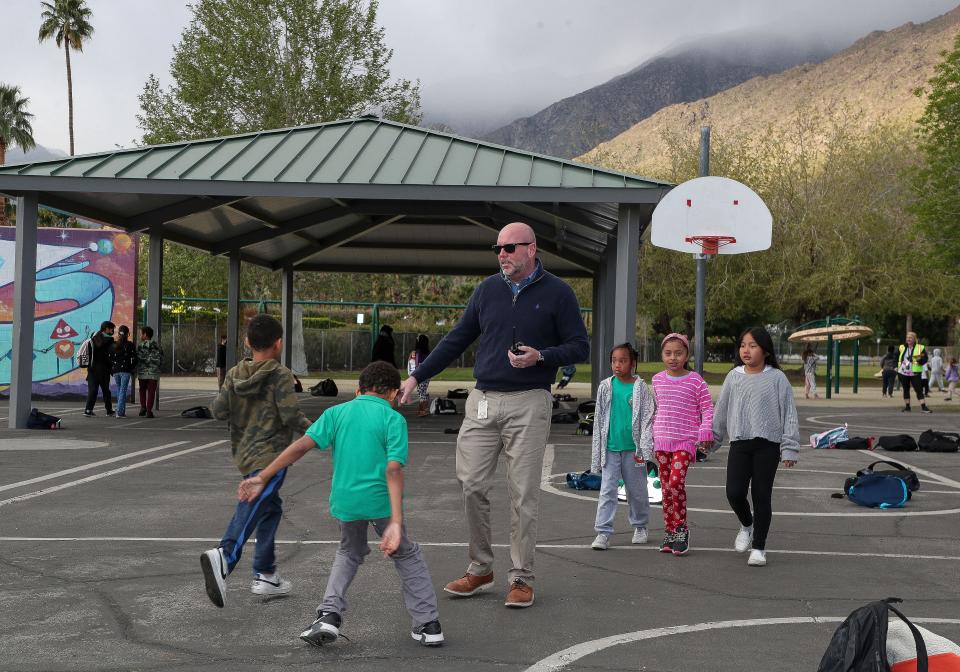
Weather’s important to monitor, because precipitation calls for a special “rainy day schedule.”
Cameron, a 2nd grader who Saunders calls the school’s resident meteorologist, chats to him about the chances of rain.
Talking weather is their morning ritual.
But Saunders can’t get too absorbed in their conversation because he has to watch 400 other students.
He does 360-degree turns on the blacktop like a roller blader as he monitors for misbehavior.
Eventually, it does rain, briefly, and a beautiful rainbow starts to play peekaboo behind the San Jacinto Mountains.
But to Cameron’s chagrin, there will be no rainy day schedule.
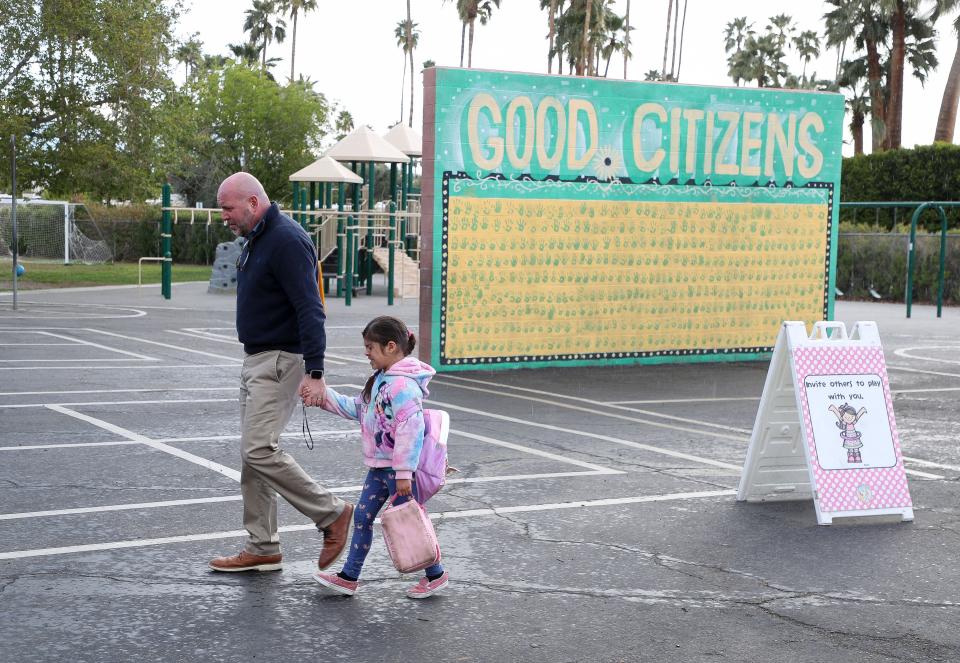
7:40 a.m.
Saunders blows his whistle. Students freeze — then line up for class.
The school day officially begins with the Pledge of Allegiance followed by the Cahuilla “No Excuses” pledge. It goes something like “I strive to do my best… No excuses, I will succeed… I am college bound.”
For the next couple hours, Saunders and I will walk from classroom to classroom checking on teachers and observing lessons.
The first 40 minutes of the school day are designated for English learning development.
More than a quarter of Cahuilla Elementary students are classified as English learners, meaning the state considers them unable to communicate fluently or learn effectively in English. English learners often come from non-English-speaking homes and backgrounds and typically require specialized or modified instruction in both the English language and in their academic courses.
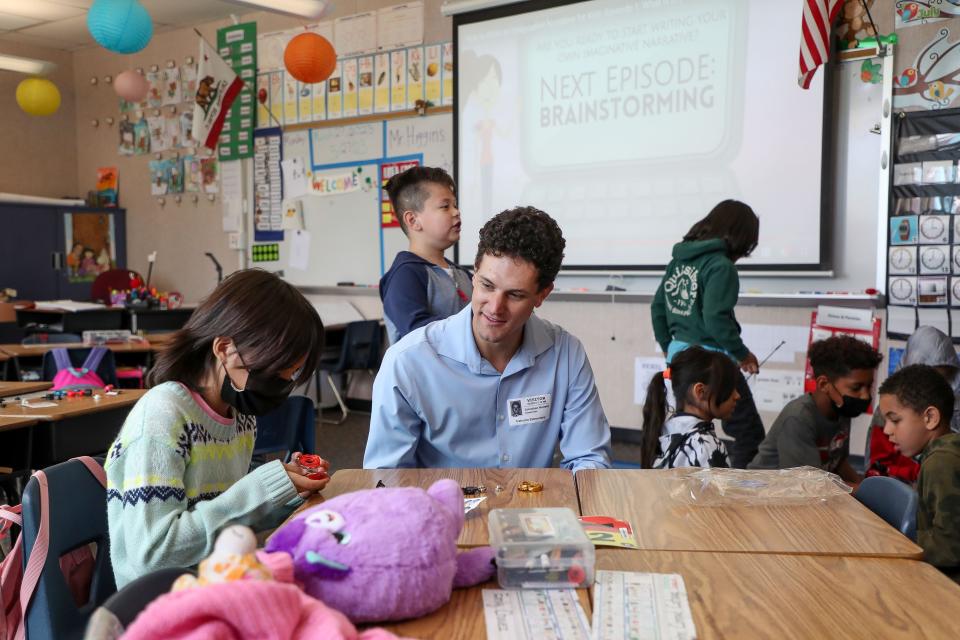
English learner progress at Cahuilla Elementary is “low” and below state average, according to state data, and only 44% of English language learners there are making progress toward English language proficiency.
Hence the administration chose to start the day with this very important subject.
We also stopped by a kindergarten class where students were learning phonetics by using gestures that correspond to sounds. For instance, kids twisted their hands for the letter “L” as if they were “squeezing a lemon.”
Unfortunately, that cute kindergarten class had an absenteeism problem.
Only 13 students out of 21 registered in the kindergarten class attended school on March 30.
“Chronic absenteeism is a problem, particularly for kindergartners,” Saunders said.
That’s because of misinformation about childrens’ obligations to attend school, Saunders said. Kindergarten is not mandatory in California, but regular attendance is mandatory for students whose families choose to enroll them.
Saunders says confusion about the state law typically leads to a large number of absences among enrolled kindergartners each year.
He added that a local factor — frequent road closures in Palm Springs due to flooding and high winds — tends to correlate with higher absences, too.
Later, we revisited the kindergarten class during their music period. Personally, I loved to see an elementary school with a dedicated music teacher because that’s something I did not have growing up. But at Cahuilla Elementary, every class has a music lesson once per week. Saunders and I saw the kindergartners learning rhythm and math. (A whole note equals four beats. A half note equals two. A quarter note, one, etc.)
I also loved to see the school’s STEAM lab, where every student at the school goes once per week to focus on a special, often hands-on lesson in science, tech, engineering arts or math.
My third highlight on our tour of every grade level from kindergarten through fifth was to see second graders studying a lesson on legendary photojournalist Jacob Riis, especially since we were joined by Desert Sun photojournalist Jay Calderon.
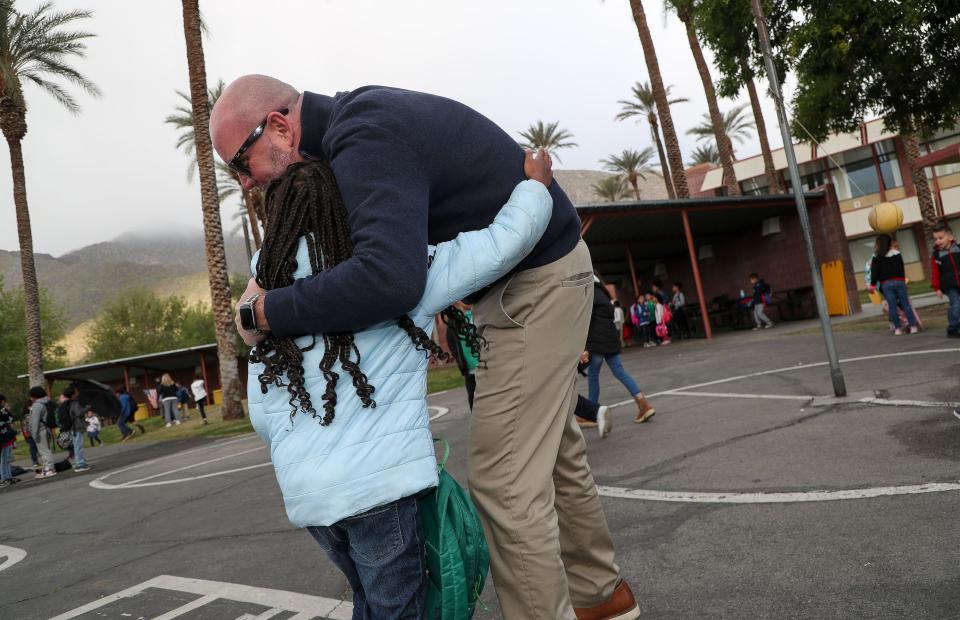
11 a.m.
It’s late morning by the time Saunders finally has a chance to return to his office and sit at his desk, but it’s hardly a break.
He has 46 new emails to open and teacher evaluations to complete.
On a typical day, he’ll work until 4:30 or 5 p.m. with no designated lunch break.
During the students’ lunch period, he’s back on the blacktop as a supervisor. Again, he makes sure kids eat. He breaks up scuffles. He checks in on students with known behavioral issues.
He is always out and about with the kids, and he makes regular posts and videos for parents online.
“I want parents to feel like they know me,” he said.
The day is a whirlwind and dismissal isn’t until 2:35 p.m.
But Saunders and I have to leave before then to attend a “Principal for a Day” luncheon at the district office down the road. While there, we’ll hear from many others, including dignitaries like Palm Springs Mayor Grace Garner and Police Chief Andy Mills, about their experiences as principal for a day at other Palm Springs Unified schools.
Then, I’m back to my office and Saunders is back to his. Or, more likely, he’s back to a classroom, or the blacktop, or a meeting with a parent or a teacher. In fact, he’ll likely be anywhere but his office. But I learned that’s sometimes what it takes to be an effective elementary school principal.
Jonathan Horwitz covers education for The Desert Sun. Reach him at jonathan.horwitz@desertsun.com.
This article originally appeared on Palm Springs Desert Sun: What's it like to be a school principal in Palm Springs? Hint: Not easy

